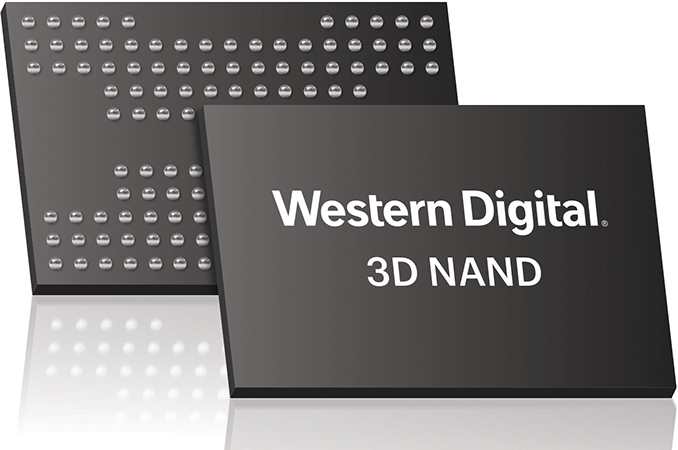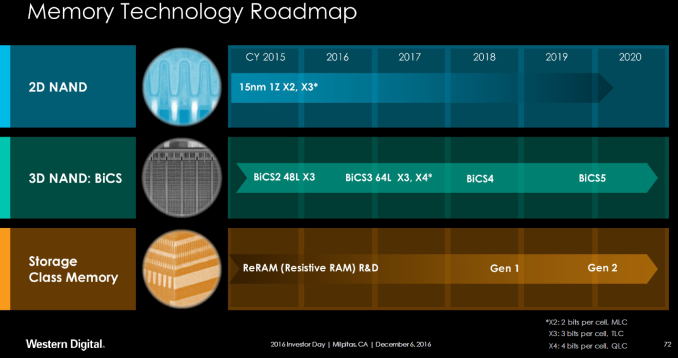Western Digital Announce BiCS4 3D NAND: 96 Layers, TLC & QLC, Up to 1 Tb per Chip
by Anton Shilov on June 28, 2017 10:00 AM EST
Western Digital on Tuesday formally announced its fourth-generation 3D NAND memory, developed as part of the Western Digital/Toshiba joint venture. The fourth-generation BiCS NAND flash chips from Western Digital feature 96 layers and will include several capacity points and will use TLC and QLC architectures. The company expects to start volume production of BiCS4 chips in 2018.
NAND dies that belong to the fourth-generation BiCS 3D NAND will use 96 word layers to minimize die size of the chips and maximize output of fabs, and at this point represents the largest layer count in the flash memory industry. Furthermore the range of BiCS4 NAND die configurations available will be considerably more diverse than BiCS3, which currently only includes 256 Gb and 512 Gb dies. Western Digital plans to offer BiCS4 components based on TLC (triple level cell) and QLC (quadruple level cell) configurations. with capacities ranging from 256 Gb to 1 Tb.
It is noteworthy that Western Digital’s BiCS4 lineup will include QLC NAND, which has been discussed by Western Digital (and SanDisk before that) for several years, but which is about to become reality only in the coming quarters. To store four bits per cell (with 16 voltage states) Western Digital had to use a “thick” process technology alongside multi-layer 3D NAND to keep the per-bit costs down. The company is not specifying how many program/erase cycles its 3D QLC NAND will handle, but various industry predictions over the years have suggested 100 – 150 P/E cycles as a reasonable goal for QLC NAND, which is considerably lower than approximately 1000 P/E cycles supported by TLC NAND. Given such endurance, it is logical to expect 3D QLC NAND to be used for primarily removable storage as well as for ultra-high capacity datacenter drives for the so-called near-WORM (write once read many) storage applications. For example, Toshiba last year discussed a QLC-based datacenter SSD with 100 TB capacity for WORM apps.
Western Digital plans to begin sampling of select 96-layer BiCS4 3D NAND configurations in the second half of this year, but the manufacturer does not specify which dies will sample when. As for mass production, Western Digital intends to start volume manufacturing of their 96-layer 256 Gb 3D NAND in 2018, with other dies to follow later. Based on Western Digital’s announcements made earlier, the company will gradually introduce more sophisticated BiCS4 96-layer configurations in 2018 and 2019, before moving to BiCS5 sometimes in 2020. That said, it makes sense to expect the highest capacity BiCS4 ICs to ship later rather than sooner.
Finally, Western Digital did not disclose whether it uses NAND string stacking technology to assemble its 96-layer 3D NAND dies, but it is a likely scenario given what industrial publications have been predicting.
Related Reading:
Source: Western Digital












22 Comments
View All Comments
theeldest - Wednesday, June 28, 2017 - link
The stacks aren't skyscrapers, they're more like pyramids (the bottoms of pyramids, at least).So the top layers aren't as large as the bottom layers.
Kristian Vättö - Thursday, June 29, 2017 - link
The actual memory strings are like skyscrapers. You are right that the overall shape is a pyramid, but the memory array is a rectangle. There are no memory cells in the wordline connectors that make the pyramid shape. You can see this in the SEM photos by TechInsights for example.MrSpadge - Wednesday, June 28, 2017 - link
The image just above your post has a bar going through the middle of the BiCS4 and BiCS5 arrays.limitedaccess - Wednesday, June 28, 2017 - link
Are buying things like USB drives and SD cards going to be a nightmare after QLC hits the market?lilmoe - Wednesday, June 28, 2017 - link
Looks like it. Unless you know exactly how you're going to use that flash and the risks associated with it, then it definitely recommend staying the heck away....cfenton - Wednesday, June 28, 2017 - link
The cheap stuff will probably all move to QLC, but I'm sure they'll keep making good stuff for prosumer and professional use.MrCommunistGen - Wednesday, June 28, 2017 - link
I know that it is inevitable... but *ugh* QLC.bill.rookard - Wednesday, June 28, 2017 - link
Agreed. And double ugh. TLC from a performance POV is only starting to get decent, and 1000 PE cycles is enough for good capacity. 150 write cycles? HEEEELLLLL no.Santoval - Wednesday, June 28, 2017 - link
"100 – 150 P/E cycles"?!? Oh dear, this QLC will really be the ultimate gutter of NAND flash..shabby - Wednesday, June 28, 2017 - link
QLC is clearly for storage and that's it, gimme a 100tb ssd with 1 p/e cycle and i'll be happy. Just need to fill it up once and that's it.